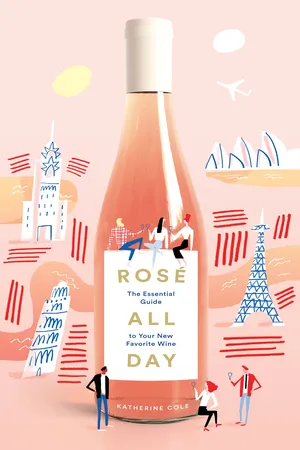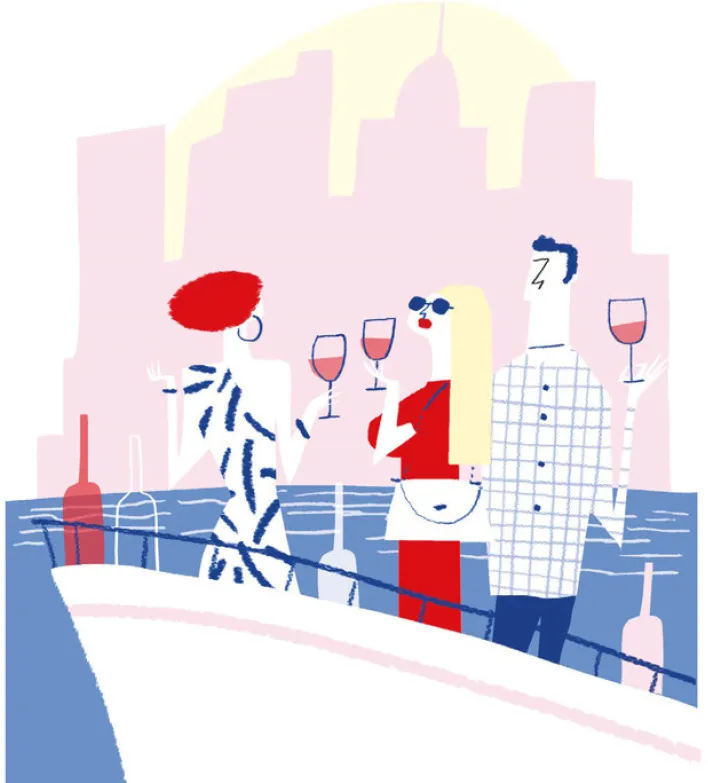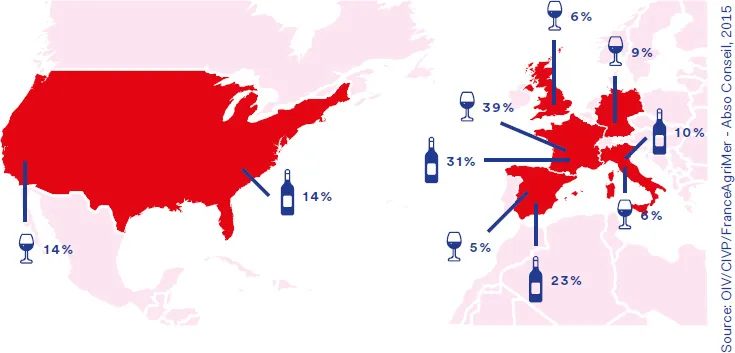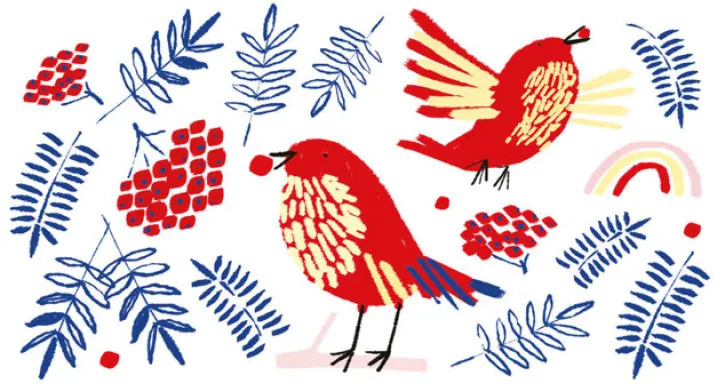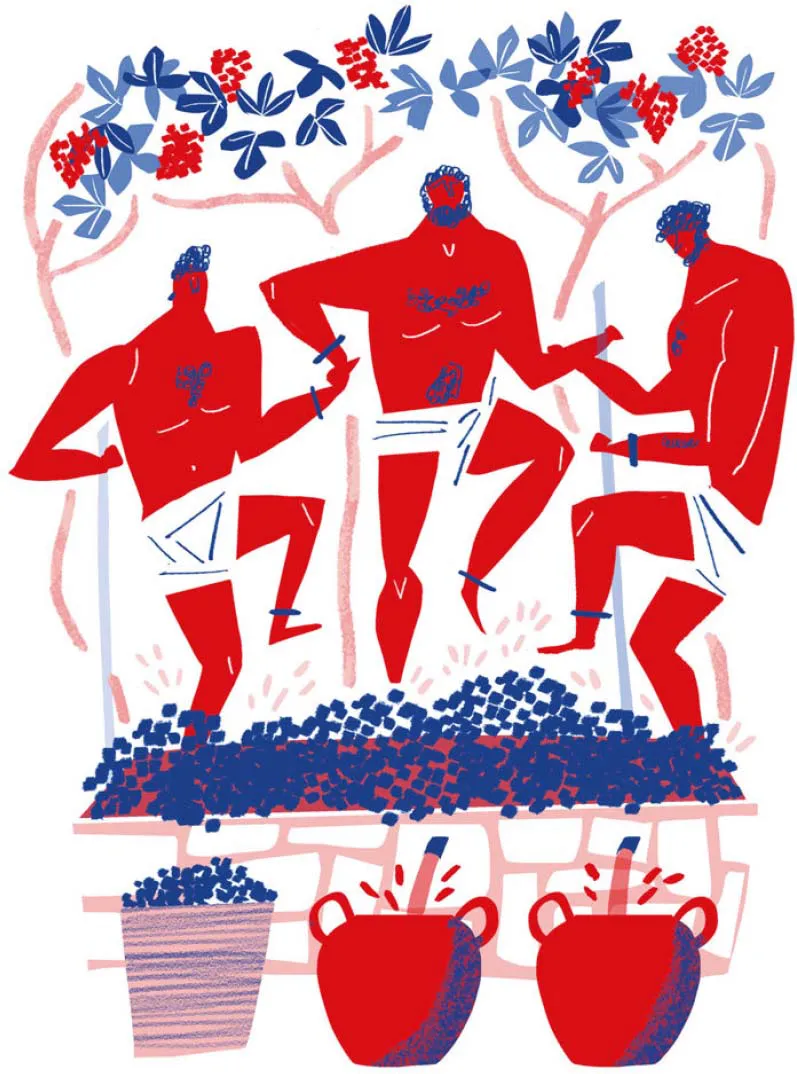![]()
CHAPTER 1
Rosé Through the Ages
On two days in June 2014, hundreds of well-heeled New Yorkers piled onto the decks of a mega-yacht to cruise up and down the Hudson River. There were fresh oysters on ice. There was a photo booth and a DJ. Someone was handing out pink Wayfarer-style sunglasses.
And there were buckets and buckets and yet more buckets of chilled rosé. Some of the wines were sparkling, with gold chips floating around in them. Some were flat. Most were from France, but some were from Lebanon, Morocco, and Turkey.
The first ninety-minute cruise filled to capacity. As did the second. And the third. And the fourth.
“La Nuit en Rosé,” as the whole affair was dubbed, sold out again in 2015 and 2016, attracting 4,500 attendees to five cruises aboard an even more mega-size mega-yacht. The party was duplicated and triplicated in Los Angeles and Miami both years. In July 2016, impresario Pierrick Bouquet6 rolled out “Pinknic,” a waterfront rosé and music festival on Governors Island, New York, at which more than 8,000 partygoers picnicked on pink blankets.
“Rosé is trending now because it makes people feel good, dream about summer vacations,” Bouquet explained. “It’s approachable, price-wise, and versatile. And rosé is not pretentious like other categories of wine that require more knowledge to be understood.” The association with partying on the Riviera, he added, didn’t hurt either.
Rosé is the new face of wine: accessible, attractive, affordable, and aspirational. In addition to the yachts, there are the movie stars and the money. In 2013, when Angelina Jolie and Brad Pitt released their Château Miraval rosé, the first 6,000 bottles sold out within five hours. In 2014, a single bottle of Sine Qua Non California rosé sold at auction for a record-breaking $42,000. That summer, multiple news outlets reported on—god forbid—a severe pink-wine shortage in the Hamptons, where rosé is also known as “Hamptons Gatorade.”
ROSÉ WINE CONSUMPTION, BY NATION
1. FRANCE 39%
2. UNITED STATES 14%
3. GERMANY 9%
4. UK AND ITALY TIED AT 6%
5. SPAIN 5%>>
ROSÉ WINE PRODUCTION, BY NATION
1. FRANCE 31%
2. SPAIN 23%
3. UNITED STATES 14%
4. ITALY 10%>>
And in a July 2015 interview on the popular podcast WTF, the multitalented boyish movie star Jason Segel confided to comedian Marc Maron that he finally sought help for his alcoholism after consuming an entire case of . . . you guessed it. That’s right: from rosé to rehab.
This pink-wine craze had all the ingredients of a passing fad. But rosé is no flash in the pan. For the past two decades, rosé’s comeback has been declared annually. It’s a rite of spring. If I had a dollar for every time I have read about the “rosé revival,” I’d buy myself a year’s supply of pink Cristal.
Along with each new vintage’s release comes the publication and posting of articles proclaiming the return of dry rosé, as if it had gone missing. All follow the same script: The trouble started in the late 1940s, when the Portuguese megabrands Lancers and Mateus débuted. These wines were fizzy, pink, and celebratory—just what everyone needed after the depredation and deprivation of World War II. At first, they were embraced. Later, wine connoisseurs would deride this genre for its short shelf life and lack of character.
Then, in 1975, California producer Sutter Home stumbled upon the formula for off-dry “White Zin.” By 1987, Sutter Home White Zinfandel was America’s bestselling wine, with annual production at two million cases. But, like Lancers and Mateus before it, the success of this beverage perplexed connoisseurs. In the words of the influential critic Robert Parker, Sutter Home is the “distressingly commercial . . . McDonald’s of wine,” producing “the cloyingly sweet” beverage.7 (For tasting notes on today’s Sutter Home “The Original” California White Zinfandel, turn to this page.)
Psychologists tell us that categorization is a basic human need. We can’t help but put things in boxes. We are hardwired to develop prejudices. So, having suffered through one too many semisweet “blush” wines, whether Portuguese or Californian, the foodie elite of the 1990s wrote off rosé as a four-letter word. Regardless of their provenance, pink wines belonged in the same grouping as Hummel figurines, leisure suits, the Cadillac Seville, and Barry Manilow albums.
Then, just as it hit rock bottom, pink wine bounced back. Stealthily, French rosé production overtook white by volume in 1994. In 2008, it claimed its position after red as the second-most-popular wine color being consumed within the borders of France, leaving white in the dust.
That same year, fortified wine marketeers jumped on board, as Croft introduced the first-ever pink Port. In 2011, Lillet, the venerable apéritif producer, added pink to its longstanding portfolio of red and white.
In 2013, the stately British paterfamilias of wine punditry, Hugh Johnson, used a rosé as the cover model for his perennial Pocket Wine Book for the first time ever. He would repeat the performance two years later.
By 2014, more than 30 percent of the wine being guzzled in France was pink. Not only had it surpassed white, but rosé now threatened the dominant position of red. That same year, an Instagram account started by a couple of blond New York–dwelling besties as a joke, @yeswayrosé, went viral and made the pages of Vogue. Rosé became a meme, a cocktail-party punch line.
And out came a new rash of articles declaring astonishment at the return of rosé. Again.
When was the last time you saw an article discussing “red wine” or “white wine” as though it were a recent discovery? What halfway decent historical account begins only seven decades ago? And what if I were to tell you that rosé has been riding up and down the waves of public adulation for thousands of years?
Beginning at the Beginning
The stories behind some of our best comestibles start not with an enterprising human, but a fearless animal. Consider a legend that takes place more than twelve hundred years ago in the Ethiopian Highlands. Kaldi, a young goatherd, found his flock hungrily feasting on plump red berries, their chins dripping with juice. The goats were bleating, hopping up and down, butting their heads against each other’s flanks, and frolicking, their tails wagging. They looked like frenzied dancers at an evening celebration.
Kaldi grabbed a twig laden with the strange red berries and popped one in his mouth. The flesh was crisp and juicy. He crunched down on two large seeds, then spat them out and waited. The goats were still dancing around and, Kaldi noticed, crunching hungrily on the seeds.
Shrugging, Kaldi tried again, this time biting down on the seeds with his molars. A deeply bitter taste was followed by a jolt of excitement. Kaldi had stumbled upon the stimulating effect of coffee beans.
Kaldi’s name and story are well known, and have been passed down through folklore. But the same plot, with anonymous players, has been enacted countless times all over the planet. Herbs, fruits, and spices have revealed their medicinal and mind-altering properties through similar random occurrences: an accidental ingestion observed by a sharp-thinking human. A line drawn between cause and effect.
A large mountain ash, Sorbus scopulina, grew behind my childhood home. In late spring, it bloomed with sprays of delicate white flowers. Then, in August, these developed into bright orange berries, as plump as tiny pumpkins. By late October, the berries began to rot and emit a sweet vinegar-like odor in the afternoon sun.
And then they came: the inevitable loud thuds, shuddering through the house, as though someone were throwing softballs against our tall dining-room windows. Suicidal birds were flying straight at us like kamikaze pilots.
In other seasons, the birds were smarter. They saw the reflection of the glass and avoided it. But in the late autumn, swallows and robins hit our windows like squash balls projected by a merciless unseen racquet. Post-impact, they lay comically splayed on our dining-room balcony, knocked out stone cold, until they eventually roused themselves and dazedly hobbled around for a few minutes before flying off.
After a few of these incidents turned out to be lethal, my parents hung up tiny aluminum-foil flags. They didn’t help. Because these birds were drunk. Sloppy drunk. They were flying while intoxicated, high on fermented ash berries. The FAA would not have approved. My mother renamed our tree the “Rocky Mountain Crashberry” in honor of them.
In Europe, the ash goes by another name: rowan. It has been associated with gods and mystical powers since prehistoric times. Like rose hips, rowanberries are better suited to tea or jelly than raw consumption, but early humans did eat these sour fruits, benefiting from their rich supply of vitamin C.
Perhaps these early ancestors did not bother to eat the berries that hung too high to be picked by hand. Until one day late in the season, a sharp-eyed person, someone like Kaldi, saw a group of birds snacking on shriveled late-season berries and then looping giddily around. Perhaps this person put two and two together, climbed the tree, gathered some of these fermented berries, and had a bit of fun with them.
Flip through books about foraging and you’ll inevitably find a timeless recipe for rowanberry wine. It’s an orangish pink color, incidentally. Could it have been the world’s first berry wine? And, at the same time, the world’s first rosé?
The First Grape Wines
Patrick McGovern, the scientific director of the Biomolecular Archae...
